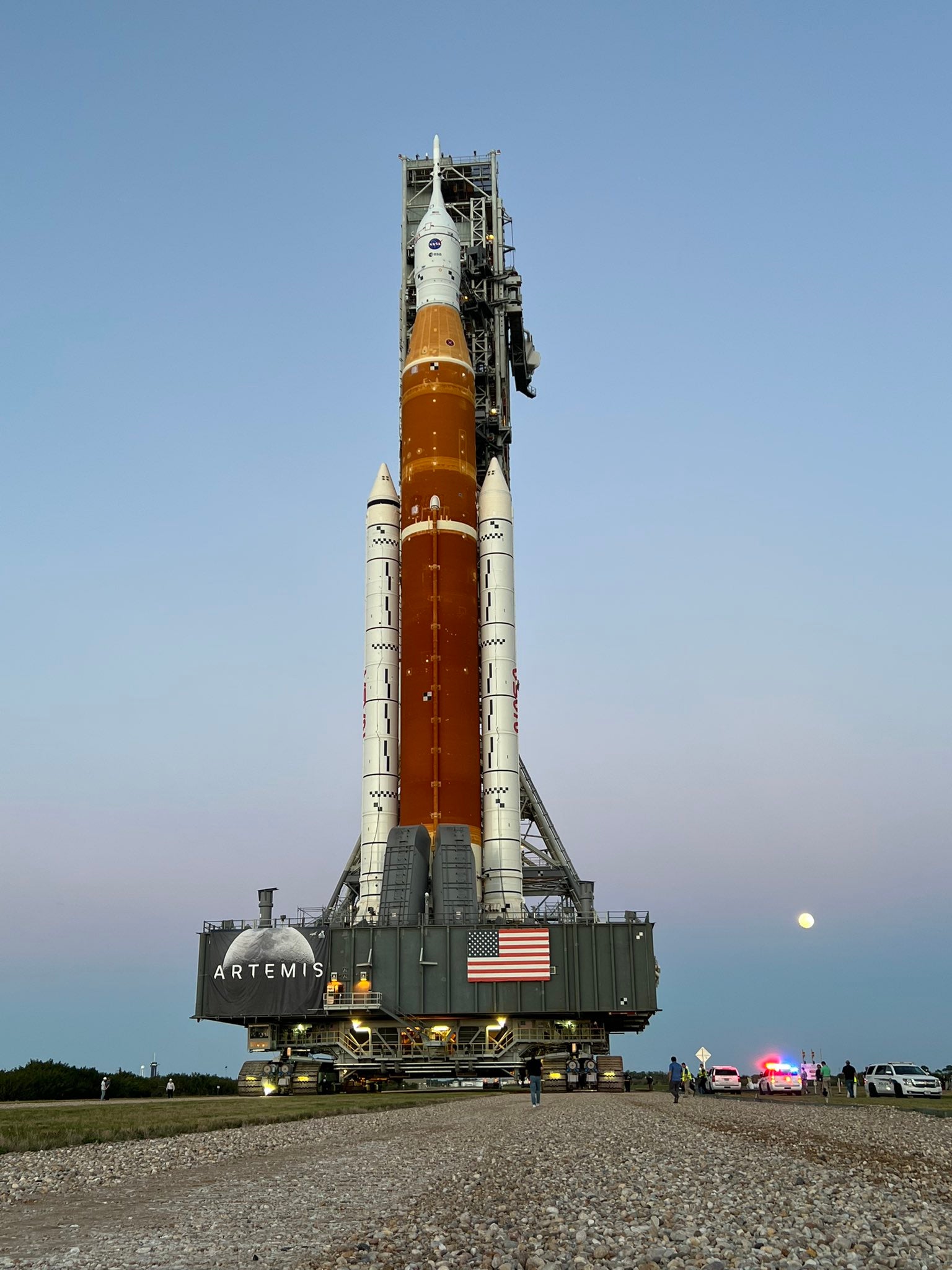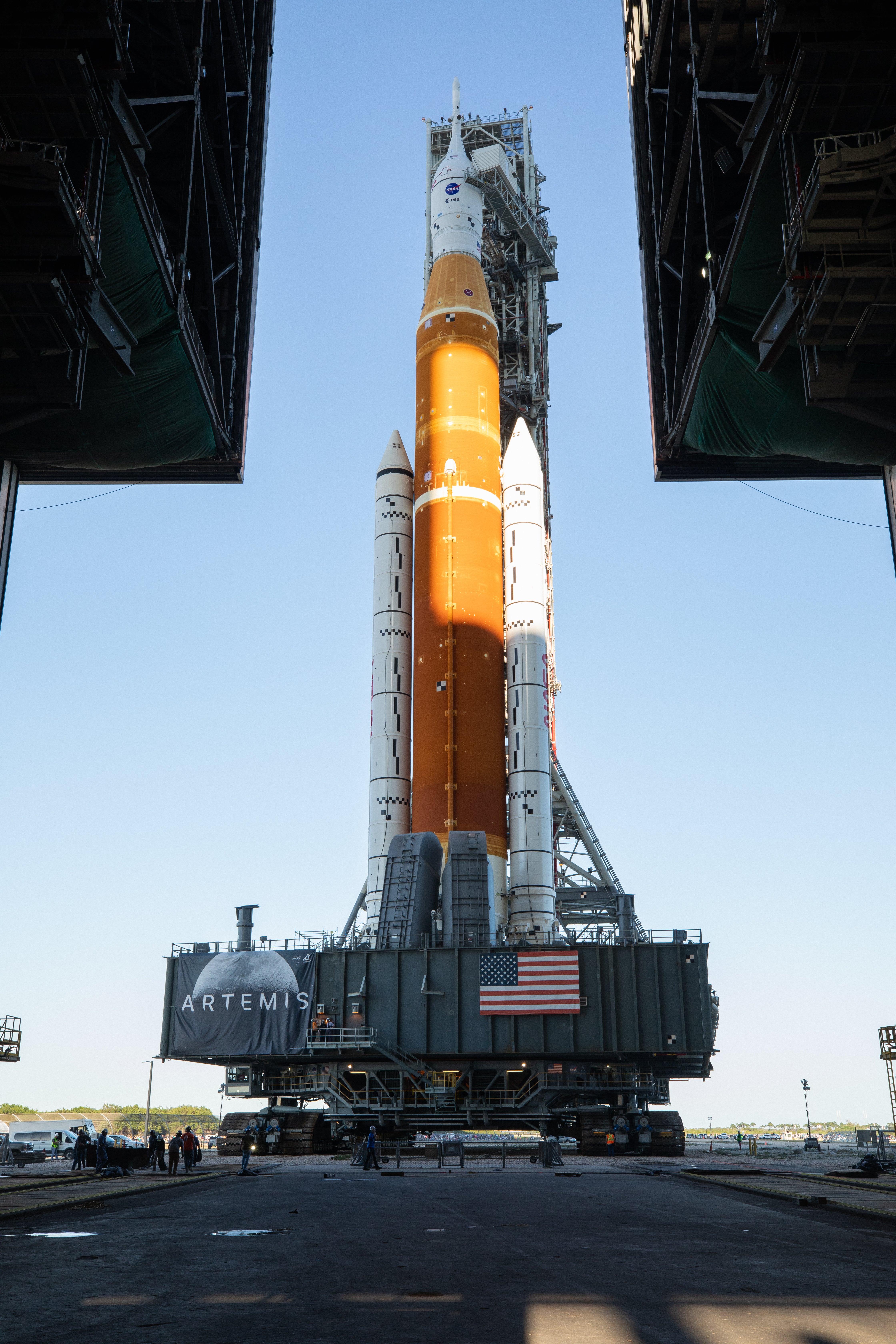Nasa finally rolls its new Moon rocket out under the moonlight
Leaving the Vehicle Assembly Building at Kennedy Space center Thursday evening, Nasa’s new Moon rocket sat on the launchpad in the early morning fog on Friday ahead of a final pre-launch test

Your support helps us to tell the story
From reproductive rights to climate change to Big Tech, The Independent is on the ground when the story is developing. Whether it's investigating the financials of Elon Musk's pro-Trump PAC or producing our latest documentary, 'The A Word', which shines a light on the American women fighting for reproductive rights, we know how important it is to parse out the facts from the messaging.
At such a critical moment in US history, we need reporters on the ground. Your donation allows us to keep sending journalists to speak to both sides of the story.
The Independent is trusted by Americans across the entire political spectrum. And unlike many other quality news outlets, we choose not to lock Americans out of our reporting and analysis with paywalls. We believe quality journalism should be available to everyone, paid for by those who can afford it.
Your support makes all the difference.The morning fog at Cape Canaveral, Florida finally cleared Friday to reveal a sight not seen in more than 50 years: a giant Nasa Moon rocket towering over launchpad 39B, the same site Nasa’s Saturn V rockets blasted off to carry Apollo astronauts to the Moon.
Nasa’s new Moon rocket, the Space Launch System, or SLS, is the largest, most powerful rocket since the Saturn V, made it to the launch pad around 4 a.m. Eastern time Friday after an almost 11-hour journey from the Vehicle Assembly Building, or VAB, at Kennedy Space Center. Along with the Orion spacecraft, SLS is the vehicle that will return humans to the Moon as part of Nasa’s Artemis Moon program.

“From this sacred and historical place, humanity will soon embark on a new era of exploration,” Nasa administrator Bill Nelson said in a statement. “Artemis I will demonstrate Nasa’s commitment and capacity to extend humanity’s presence on the Moon – and beyond.”
Nasa spent months preparing the rocket inside the VAB for an upcoming flight test, but had to roll the rocket to the launchpad for a final critical test known as a “wet dress rehearsal,” “wet” because it involves loading and loading the rocket with cryogenic fuel. Scheduled for 1 April, the results of the wet dress rehearsal will determine when Nasa launches the flight test, which could come as early as 7 May, though Nasa is also eyeing launch windows as late as early July.
The flight test will be known as Artemis I, an uncrewed test of the SLS rocket and Orion spacecraft that will send Orion on a flyby of the Moon and beyond before returning to Earth. If all goes well, Nasa plans to launch a crewed lunar flyby, Artemis II, in May 2024. Artemis III, the mission to return humans to the lunar surface, including the first woman to walk on the Moon, could take place sometime in 2025.
But before any Moonshots, SLS and Orion had to “roll out” of the VAB and make their way to the launchpad just after 5 p.m. Eastern on Thursday evening. Nasa uses the term “roll,” but it was more of a crawl — the 3.5 million pound rocket and mobile launcher carried at a top speed of about 1.5 kilometers per hour atop Nasa’s treaded “crawler” vehicle.
During the slow by steady progress overnight, Nasa photographers took photos of SLS, including one of the rocket posed against the backdrop of its eventual target — a nearly full Moon.
Nasa has also shared images to social media comparing SLS to the Saturn V rocket as it left the VAB or stood in the moonlight at launch complex 39B, but observers will note obvious differences. Whereas the Saturn five was a singular, large rocket in a black and white color motif, the SLS consists of a burnt orange core stage flanked by two white solid rocket boosters, a color scheme, and configuration reminiscent of the space shuttle.
SLS makes use of some technologies from the space shuttle program, such as solid rocket boosters, but the rocket is a next generation vehicle, designed to launch crew and cargo into orbit, to the Moon, and into deep space. The current SLS configuration, known as Block 1, rises 322 feet tall, just 41 feet shy of the 363-foot height of the Saturn V. But block 1 produces 8.8 million pounds of thrust, 15% more than the Saturn V, allowing the SLS to deliver up to 27 tonnes of material to the Moon.
Nasa plans to later upgrade the SLS to the Block 2 configuration with a more powerful upper stage, which will tower 384 feet above the launch pad and propel 43 to 46 tonnes of material and crew to the Moon. Block 2 will be the second-largest rocket in the world, with only the fully stacked SpaceX Starship and super-heavy booster coming in larger.
The European Space Agency also shared photos of the SLS rollout on social media channels, with ESA director general Josef Aschbacher sharing on Twitter his congratulations to his US counterparts.
The SLS may stay on the pad in Florida for up to a month for additional testing after the wet dress rehearsal before rolling back into the VAB for final preparations for the Artemis I launch. It will next roll out about a week before that launch, the first test flight of the SLS launch system.
Join our commenting forum
Join thought-provoking conversations, follow other Independent readers and see their replies
Comments